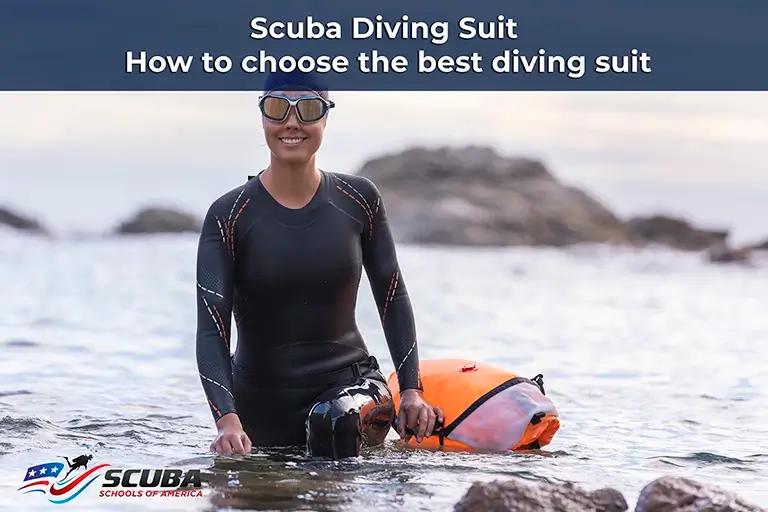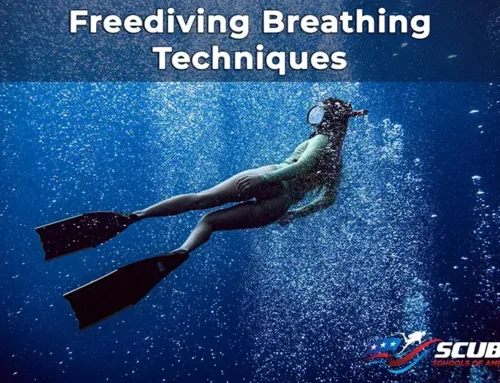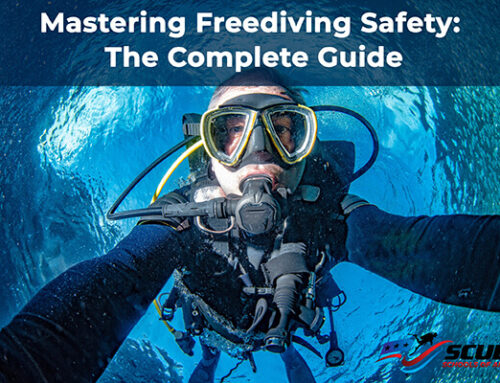Scuba diving is an exciting and adventurous way to explore the underwater world, but your experience can be significantly impacted by your gear choice, especially when selecting the right scuba diving suit.
A well-fitting suit that meets your specific diving needs will keep you comfortable, warm, and safe, allowing you to make the most of your underwater excursions. Whether you’re a beginner or an experienced diver, Scuba Schools of America emphasizes the importance of choosing the right gear to ensure a safe and enjoyable diving experience.
The Purpose of a Scuba Diving Wetsuit
A scuba diving suit is an essential piece of gear designed to provide thermal insulation, ensuring divers stay warm in cold water. By creating a protective barrier between your body and the surrounding water, a wetsuit minimizes heat loss, allowing for a more comfortable and safer diving experience.
When Should You Buy a Scuba Diving Suit?
For recreational divers, the decision to buy a wetsuit often comes during or after Open Water training. Owning a personal wetsuit ensures a perfect fit, which improves comfort and thermal protection. Additionally, a personal wetsuit reduces hygiene concerns that may come with renting gear.
However, if you only plan to dive occasionally—just a few times a year—it may be more cost-effective to rent rather than purchase a wetsuit. On the other hand, if you plan on diving more than 20 times a year, the cost of renting will likely exceed the investment of owning your own gear. To make the best decision, calculate the cost per use of a personal wetsuit and compare it to rental prices at your preferred dive center.
Whether renting or buying, ensuring that your scuba diving suit is appropriate for your diving conditions is key to a comfortable and enjoyable underwater experience. Scuba Schools of America provides expert guidance to help divers choose the right wetsuit based on their individual needs and diving frequency.
What Diving Suit Should I Take?
Many divers assume that a shorty or a lycra suit is sufficient for tropical destinations. However, this assumption should be reconsidered to avoid discomfort or potential risks during a dive. Let’s review the key features of diving suits to determine the best choice for Blue Force destinations.
What is a Diving Suit Made Of?
Neoprene is the most commonly used material in wetsuit manufacturing. This closed-cell foam traps millions of tiny gas bubbles within its structure, preventing water from passing through.
Typically, neoprene is sandwiched between layers of elastic fabric (such as nylon or lycra) to enhance its durability and allow seams to be stitched together. Unlike open-cell foam (which absorbs water like a sponge), neoprene prevents water circulation inside the suit.
If a suit fits snugly at the cuffs, ankles, and neck, only a minimal amount of water will enter initially, forming a thin layer that the body warms up. Neoprene, as an insulator, helps retain this heat, keeping the diver warm.
However, due to the gas bubbles within the material, neoprene also adds buoyancy, necessitating additional weights for diving. Neoprene wetsuits are categorized based on thickness, elasticity, thermal protection, and buoyancy.
Nowadays, most scuba diving suits are made of high-quality neoprene that balances flexibility and thermal protection. The primary factor in choosing a wetsuit is how well it fits and how comfortable it feels, rather than the type of neoprene used.
How to Choose a Diving Suit?
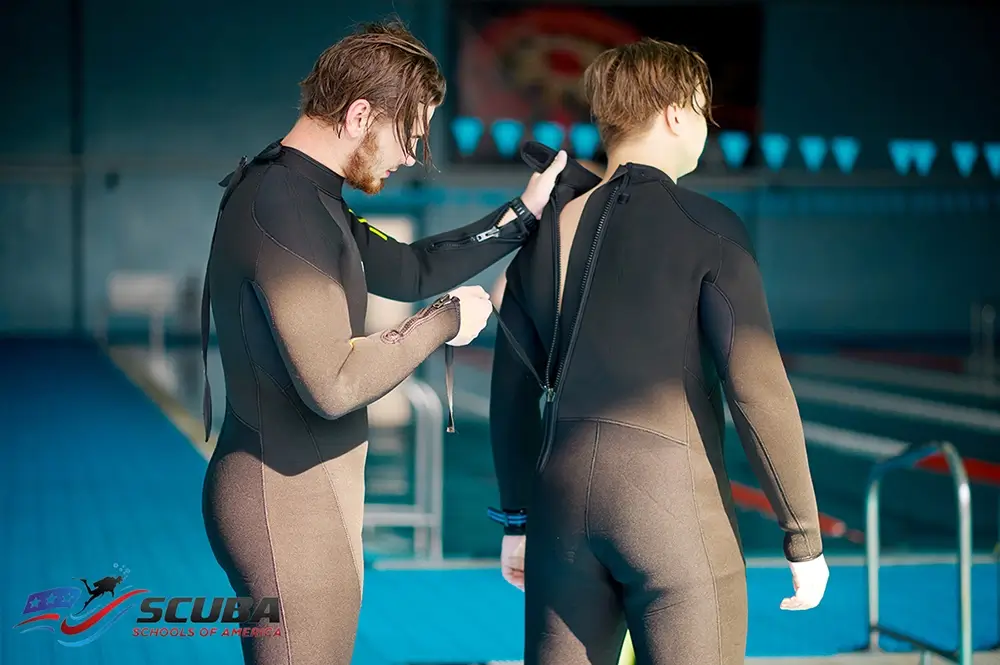
1. Correct Fit:
The scuba diving suit should neither be too loose nor too tight. If it does not fit properly, water will circulate freely between the suit’s interior and exterior, reducing its thermal protection. Conversely, an overly tight suit can restrict blood circulation, make breathing difficult, or cause skin irritation.
An ideal wetsuit should fit like a second skin—snug but not restrictive. Keep in mind that wetsuits feel tighter when dry than when submerged in water. Over time, neoprene can lose thickness in high-pressure areas, particularly around the joints.
2. Thickness:
The thicker the wetsuit, the better it protects against the cold. Neoprene functions by creating an insulating layer between the water and the skin, with the body heating the thin sheet of water trapped inside the suit.
Some suits have variable thickness—thinner in areas requiring more flexibility (arms and legs) and thicker in areas needing greater thermal protection (chest and back).
- 3mm wetsuits are ideal for tropical waters (26°C–30°C).
- 5mm wetsuits work well in waters between 22°C–27°C.
- 7mm wetsuits are recommended for waters between 18°C–22°C.
The buoyancy of a diving suit is directly related to its thickness thicker suits provide more buoyancy, requiring additional ballast.
3. Type of Suit:
Common types include shorty suits, full one-piece suits, double-piece suits, semi-dry suits, and dry suits. Most modern wetsuits are one-piece with zippers for easy wear. However, zippers can be a point of water entry, which may not be an issue in warm waters but is significant in colder conditions, where a dry zipper is preferable.
Double-piece wetsuits, often favored by free divers, do not have zippers, making them more flexible and comfortable while reducing water circulation. This provides superior thermal protection at the same thickness but can be more challenging to put on.
4. Details to Consider:
When choosing a diving suit, consider important design features such as snug seals at cuffs, ankles, and neck to minimize water entry. Reinforced patches in high-wear areas (knees, elbows, shoulders) enhance durability.
Fit is critical to comfort—years ago, wetsuits had a generic, one-size-fits-all design, but today, they are available in various cuts tailored for men, women, and different body types. Some manufacturers even offer custom-made wetsuits for a perfect fit.
By carefully selecting the right scuba diving suit, divers can enhance their comfort, safety, and performance in the water. Schools such as Scuba Schools of America emphasize proper gear selection as a fundamental part of dive training, ensuring that every diver is well-equipped for their underwater adventures.
Wetsuits for Different Climates
Whether you are planning to scuba dive in tropical waters or icy currents, there is a scuba diving suit designed to meet the unique challenges of each climate. Choosing the right wetsuit is essential for maintaining comfort, flexibility, and protection while diving. Understanding the nuances of each wetsuit type will help you make an informed decision for your diving adventures.
Diving Wetsuits for Warm Climates
Scuba diving in warm climates typically involves water temperatures above 24°C. In such warm waters, the primary function of a wetsuit is to provide protection against cuts, stings, and sunburn rather than to offer thermal insulation.
Shorties are an excellent choice for these conditions. Covering the torso and extending to the mid-thigh and upper arms, they provide a balance between protection and freedom of movement. Typically made from 2mm to 3mm neoprene, these suits are lightweight, easy to put on and take off, and offer great flexibility while diving.
Diving Wetsuits for Winter or Cold Climates
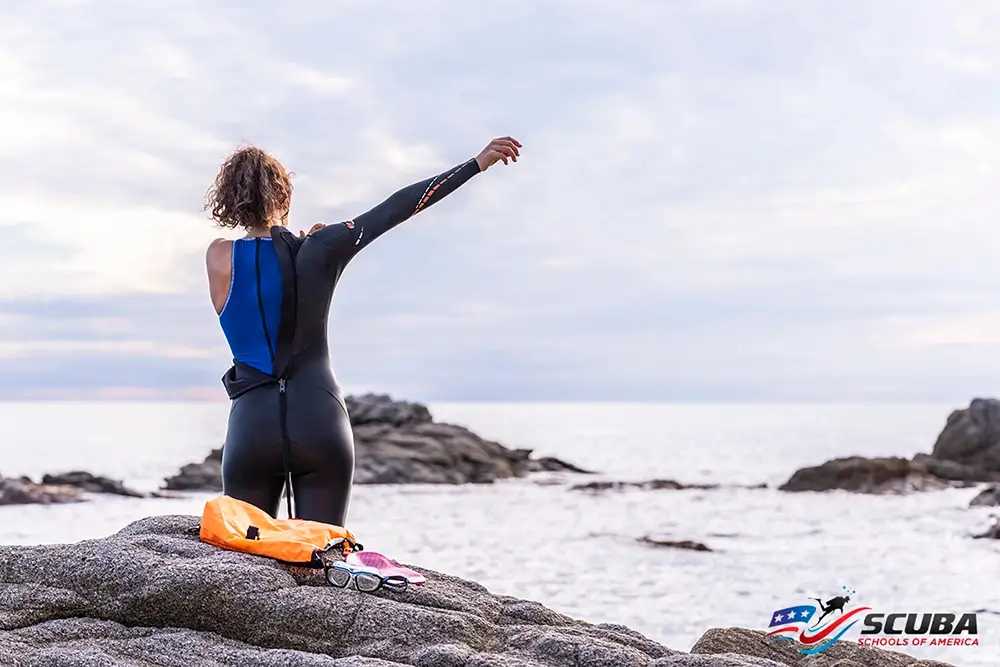
Scuba diving in winter or colder climates requires special consideration, as water temperatures often drop below 18°C. If you are diving in regions such as the UK, selecting a wetsuit with adequate insulation is essential for maintaining warmth and safety.
Full wetsuits are commonly used in colder climates, as they provide full-body coverage, including arms and legs. For water temperatures between 10°C and 18°C, a 5mm to 7mm wetsuit is generally sufficient. However, for temperatures below 10°C (50°F), a scuba diving drysuit or a semi-drysuit may be necessary.
- Semi-drysuits resemble full wetsuits but have better seals at the wrists, ankles, and neck to minimize water circulation. They are typically made from 7mm to 8mm neoprene, offering improved insulation.
- Drysuits, on the other hand, provide the highest level of warmth by completely sealing out water and using insulating air or gas. These are ideal for extremely cold diving conditions.
It is also important to consider individual cold tolerance when choosing a wetsuit. Some divers may require additional layers, such as thermal rash guards or undersuits, to stay warm in colder waters.
Do I Need a Lined Wetsuit?
Whether or not you need a lined scuba diving suit depends on the environmental conditions you will be diving in. Lined wetsuits offer additional insulation, making them ideal for colder waters.
Lining materials, such as fleece, create an extra layer that helps trap heat close to your body. If you are planning to dive in cold temperatures, a lined wetsuit can significantly enhance warmth and comfort. However, for warm-water diving, a lined wetsuit may be unnecessary and could even lead to overheating.
Features of Scuba Diving Wetsuits to Consider
Seals and Zippers
High-quality seals and zippers can greatly affect a wetsuit’s thermal efficiency. Look for glide skin or smooth-skin seals, which provide a better seal against your skin, reducing water entry. Similarly, water-resistant zippers prevent cold water from flushing into the suit, keeping you warmer during your dive.
Color and Style
While functionality should be the primary focus when selecting a scuba diving suit, color and style can also be factors. Darker colors tend to fade less with sun exposure, while brighter colors improve visibility, which can enhance safety during buddy checks or emergency situations.
Integrated Hoods and Knee Pads
Additional features such as integrated hoods and reinforced knee pads can improve comfort and extend the lifespan of your wetsuit. Hoods help reduce heat loss from your head, which is crucial for cold-water diving. Knee pads add durability, protecting the suit from wear and tear when kneeling or making contact with rough surfaces.
Seams and Stitching
The type of seams and stitching plays a significant role in a wetsuit’s durability and insulation.
- Flatlock seams: Common and inexpensive, these are best for warm-water wetsuits as they are not waterproof.
- Glued and blind-stitched seams: These provide better insulation and are suitable for cold-water diving.
- Liquid-sealed seams: Found in high-end wetsuits, these use a liquid rubber compound to completely seal the seams, making them highly durable and waterproof.
By selecting the right scuba diving suit, divers can ensure a safer and more enjoyable experience in any climate.
Scuba Schools of America stresses the importance of properly fitting wetsuits, considering factors such as thickness, material, and design to optimize both protection and performance underwater.
Care and Maintenance for Your Diving Wetsuit
To keep your scuba diving suit in optimal condition, it is essential to rinse it thoroughly with fresh water after each dive to remove salt, chlorine, and other contaminants. Proper maintenance ensures the suit remains flexible and durable, providing the best insulation and protection during dives.
Avoid exposing your wetsuit to direct sunlight for prolonged periods, as UV rays can degrade the neoprene material. When storing, use a wide hanger to prevent creases and folds that could weaken the suit. Regularly inspect your wetsuit for signs of wear and tear, and address any small damages promptly to prevent further deterioration. By following these care guidelines, you can ensure your scuba diving suit stays in excellent condition for many diving adventures to come.
Types of Scuba Diving Wetsuits
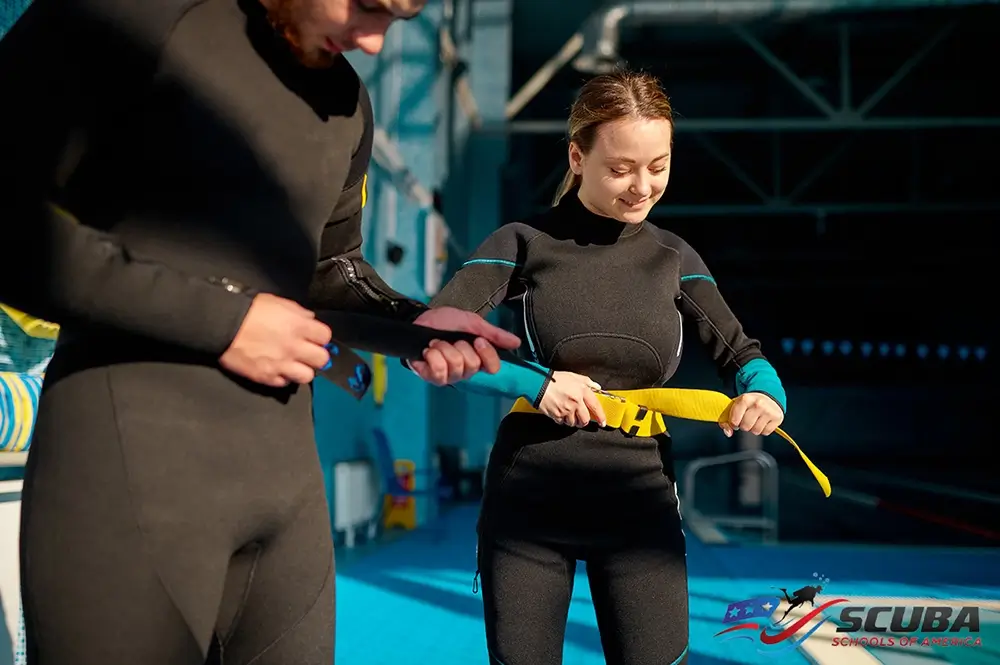
There are several types of scuba diving suits to choose from, each offering unique benefits depending on your diving conditions and personal preferences. Scuba Schools of America recommends selecting a wetsuit based on water temperature, insulation needs, and overall comfort to ensure a safe and enjoyable diving experience.
1. Shorties
Shorty wetsuits have short sleeves and short legs, providing minimal coverage and insulation. They are ideal for warm-water diving, offering lightweight flexibility and ease of movement. These suits are perfect for tropical destinations where protection from stings, scrapes, and sun exposure is more important than thermal insulation.
2. Full Suits
Full wetsuits cover the entire body, including arms and legs, offering maximum insulation and protection. These are the preferred scuba diving suits for colder water temperatures, winter diving, and extended underwater exposure. The added coverage reduces heat loss and provides additional defense against jellyfish stings, rough coral, and other underwater hazards.
3. Spring suit
Spring suits are a hybrid design featuring either long sleeves with short legs or short sleeves with long legs. They balance coverage and flexibility, making them suitable for moderate water temperatures. Compared to shorties, springsuits provide better protection against sunburn, abrasions, and mild cold exposure.
4. Semi-Dry Wetsuits
Semi-dry wetsuits are designed for enhanced thermal insulation, making them a great choice for cold-water diving. They feature sealed seams and tight-fitting wrist and ankle seals and often include an integrated hood to minimize water entry and circulation.
Although semi-dry wetsuits are more expensive than standard wetsuits, they provide significant benefits for divers who frequently explore cold waters. If you’re considering a semi-dry suit, weigh the pros and cons based on your diving habits and preference for warmth versus flexibility.
5. Farmer Johns
Farmer John wetsuits consist of sleeveless long johns worn beneath a separate jacket, offering extra insulation while maintaining flexibility. This two-piece design is versatile, allowing divers to adjust layers according to water temperature. Farmer John wetsuits are popular among free divers and divers who frequently transition between different water conditions.
Choosing the Right Scuba Diving Suit
When selecting a wetsuit, consider factors such as:
- Water temperature: Warmer waters require thinner suits, while colder environments demand thicker insulation.
- Insulation level: Choose a suit that balances warmth with flexibility.
- Fit and flexibility: A properly fitted wetsuit should feel snug without restricting movement.
By choosing the right scuba diving suit, divers can ensure a comfortable and safe experience underwater.
Get in Touch with Scuba Schools of America
For all your scuba diving needs, including expert guidance on selecting the perfect diving suit, Scuba Schools of America is here to assist you. Whether you need information about training programs, gear selection, equipment rentals, or dive certifications, our team of professionals is ready to help.
Visit us at our Montclair, California, location, give us a call, or reach out through our website for personalized assistance. At Scuba Schools of America, we are dedicated to ensuring every diver, from beginners to seasoned professionals, has the best possible underwater experience. Contact us today and start your scuba diving journey with confidence!

